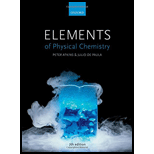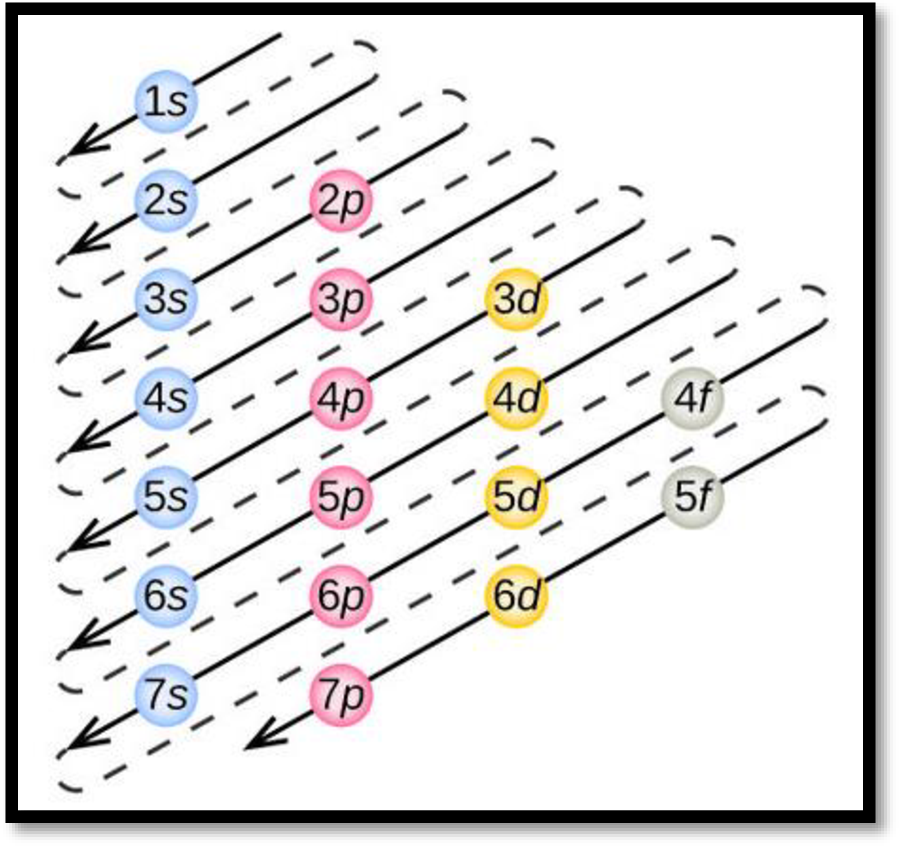
Elements Of Physical Chemistry
7th Edition
ISBN: 9780198796701
Author: ATKINS, P. W. (peter William), De Paula, Julio
Publisher: Oxford University Press
expand_more
expand_more
format_list_bulleted
Question
Chapter 8, Problem 8B.3ST
Interpretation Introduction
Interpretation:
The ground state electronic configuration of magnesium atom has to be identified.
Concept-Introduction:
Aufbau principle:
- Electrons first occupy orbitals with lower energy than higher energy.
- An orbital can be occupied only by two electrons having opposite spins.
- Each electron fills each orbital till it is half filled. Greater the number of parallel spins of electrons more stable the orbital. This is known as Hund’s rule.
- The order of electrons filling in an atom is given as

Figure 1
Expert Solution & Answer
Want to see the full answer?
Check out a sample textbook solution
Students have asked these similar questions
Draw out the SALCs of wach orbital in a AlCl3 molecule.
Which of the following is 3-ethyl-2-methylpentane?
х
Can you please help me with this problem and explain it step by step? I'm so confused about it
Chapter 8 Solutions
Elements Of Physical Chemistry
Ch. 8 - Prob. 8A.1STCh. 8 - Prob. 8A.2STCh. 8 - Prob. 8A.3STCh. 8 - Prob. 8A.4STCh. 8 - Prob. 8A.5STCh. 8 - Prob. 8B.2STCh. 8 - Prob. 8B.3STCh. 8 - Prob. 8B.4STCh. 8 - Prob. 8C.1STCh. 8 - Prob. 8C.2ST
Ch. 8 - Prob. 8D.1STCh. 8 - Prob. 8D.2STCh. 8 - Prob. 8D.3STCh. 8 - Prob. 8D.4STCh. 8 - Prob. 8D.5STCh. 8 - Prob. 8D.6STCh. 8 - Prob. 8D.7STCh. 8 - Prob. 8A.1ECh. 8 - Prob. 8A.2ECh. 8 - Prob. 8A.3ECh. 8 - Prob. 8A.6ECh. 8 - Prob. 8A.7ECh. 8 - Prob. 8A.8ECh. 8 - Prob. 8A.9ECh. 8 - Prob. 8A.10ECh. 8 - Prob. 8A.12ECh. 8 - Prob. 8B.1ECh. 8 - Prob. 8B.2ECh. 8 - Prob. 8B.3ECh. 8 - Prob. 8C.1ECh. 8 - Prob. 8C.2ECh. 8 - Prob. 8D.1ECh. 8 - Prob. 8D.2ECh. 8 - Prob. 8D.3ECh. 8 - Prob. 8D.4ECh. 8 - Prob. 8D.5ECh. 8 - Prob. 8D.6ECh. 8 - Prob. 8D.7ECh. 8 - Prob. 8D.8ECh. 8 - Prob. 8D.9ECh. 8 - Prob. 8D.11ECh. 8 - Prob. 8D.12ECh. 8 - Prob. 8.1DQCh. 8 - Prob. 8.2DQCh. 8 - Prob. 8.3DQCh. 8 - Prob. 8.4DQCh. 8 - Prob. 8.5DQCh. 8 - Prob. 8.6DQCh. 8 - Prob. 8.7DQCh. 8 - Prob. 8.8DQCh. 8 - Prob. 8.2PCh. 8 - Prob. 8.4PCh. 8 - Prob. 8.7PCh. 8 - Prob. 8.8PCh. 8 - Prob. 8.9PCh. 8 - Prob. 8.11PCh. 8 - Prob. 8.12P
Knowledge Booster
Learn more about
Need a deep-dive on the concept behind this application? Look no further. Learn more about this topic, chemistry and related others by exploring similar questions and additional content below.Similar questions
- 2. Identify the reagents you would need to achieve the following. You may need to consider using a protecting group. HO 1. 2. 3. 4. 5. OH Br HOarrow_forwardBeF2 exists as a linear molecule. Which kind of hybrid orbitals does Be use in this compound? Use Orbital Diagrams to show how the orbitals are formed. (6)arrow_forwardPlease answer the questions and provide detailed explanations as well as a drawing to show the signals in the molecule.arrow_forward
- Propose an efficient synthesis for the following transformation: EN The transformation above can be performed with some reagent or combination of the reagents listed below. Give the necessary reagents in the correct order, as a string of letters (without spaces or punctuation, such as "EBF"). If there is more than one correct solution, provide just one answer. A. t-BuOK B. Na2Cr2O7, H2SO4, H2O C. NBS, heat F. NaCN D. MeOH E. NaOH G. MeONa H. H2O I. 1) O3; 2) DMSarrow_forwardStereochemistry Identifying the enantiomer of a simple organic molecule 1/5 Check the box under each structure in the table that is an enantiomer of the molecule shown below. If none of them are, check the none of t above box under the table. Br ま HO H 0 Molecule 1 Molecule 2 Molecule 3 OH H Br H H" Br OH Br Molecule 4 Br H OH + + OH Molecule 5 Br H OH none of the above Molecule 6 Br H... OHarrow_forwardPlease answer the questions and provide detailed explanations.arrow_forward
- Question 16 0/1 pts Choose the correct option for the following cycloaddition reaction. C CF3 CF3 CF3 CF3 The reaction is suprafacial/surafacial and forbidden The reaction is antarafacial/antarafacial and forbidden The reaction is antarafacial/antarafacial and allowed The reaction is suprafacial/surafacial and allowedarrow_forward1. Give the structures of the products obtained when the following are heated. Include stereochemistry where relevant. A NO2 + NO2 B + C N=C CEN + { 2. Which compounds would you heat together in order to synthesize the following?arrow_forwardExplain how myo-inositol is different from D-chiro-inositol. use scholarly sources and please hyperlink.arrow_forward
- What is the molarisuty of a 0.396 m glucose solution if its density is 1.16 g/mL? MM glucose 180.2 /mol.arrow_forwardProvide the proper IUPAC or common name for the following compound. Dashes, commas, and spaces must be used correctly. Br ......Im OHarrow_forwardCan you please help me solve this problems. The top one is just drawing out the skeletal correct and then the bottom one is just very confusing to me and its quite small in the images. Can you enlarge it and explain it to me please. Thank You much (ME EX1) Prblm #33arrow_forward
arrow_back_ios
SEE MORE QUESTIONS
arrow_forward_ios
Recommended textbooks for you
 ChemistryChemistryISBN:9781305957404Author:Steven S. Zumdahl, Susan A. Zumdahl, Donald J. DeCostePublisher:Cengage Learning
ChemistryChemistryISBN:9781305957404Author:Steven S. Zumdahl, Susan A. Zumdahl, Donald J. DeCostePublisher:Cengage Learning ChemistryChemistryISBN:9781259911156Author:Raymond Chang Dr., Jason Overby ProfessorPublisher:McGraw-Hill Education
ChemistryChemistryISBN:9781259911156Author:Raymond Chang Dr., Jason Overby ProfessorPublisher:McGraw-Hill Education Principles of Instrumental AnalysisChemistryISBN:9781305577213Author:Douglas A. Skoog, F. James Holler, Stanley R. CrouchPublisher:Cengage Learning
Principles of Instrumental AnalysisChemistryISBN:9781305577213Author:Douglas A. Skoog, F. James Holler, Stanley R. CrouchPublisher:Cengage Learning Organic ChemistryChemistryISBN:9780078021558Author:Janice Gorzynski Smith Dr.Publisher:McGraw-Hill Education
Organic ChemistryChemistryISBN:9780078021558Author:Janice Gorzynski Smith Dr.Publisher:McGraw-Hill Education Chemistry: Principles and ReactionsChemistryISBN:9781305079373Author:William L. Masterton, Cecile N. HurleyPublisher:Cengage Learning
Chemistry: Principles and ReactionsChemistryISBN:9781305079373Author:William L. Masterton, Cecile N. HurleyPublisher:Cengage Learning Elementary Principles of Chemical Processes, Bind...ChemistryISBN:9781118431221Author:Richard M. Felder, Ronald W. Rousseau, Lisa G. BullardPublisher:WILEY
Elementary Principles of Chemical Processes, Bind...ChemistryISBN:9781118431221Author:Richard M. Felder, Ronald W. Rousseau, Lisa G. BullardPublisher:WILEY

Chemistry
Chemistry
ISBN:9781305957404
Author:Steven S. Zumdahl, Susan A. Zumdahl, Donald J. DeCoste
Publisher:Cengage Learning

Chemistry
Chemistry
ISBN:9781259911156
Author:Raymond Chang Dr., Jason Overby Professor
Publisher:McGraw-Hill Education

Principles of Instrumental Analysis
Chemistry
ISBN:9781305577213
Author:Douglas A. Skoog, F. James Holler, Stanley R. Crouch
Publisher:Cengage Learning

Organic Chemistry
Chemistry
ISBN:9780078021558
Author:Janice Gorzynski Smith Dr.
Publisher:McGraw-Hill Education

Chemistry: Principles and Reactions
Chemistry
ISBN:9781305079373
Author:William L. Masterton, Cecile N. Hurley
Publisher:Cengage Learning

Elementary Principles of Chemical Processes, Bind...
Chemistry
ISBN:9781118431221
Author:Richard M. Felder, Ronald W. Rousseau, Lisa G. Bullard
Publisher:WILEY
Quantum Numbers, Atomic Orbitals, and Electron Configurations; Author: Professor Dave Explains;https://www.youtube.com/watch?v=Aoi4j8es4gQ;License: Standard YouTube License, CC-BY
QUANTUM MECHANICAL MODEL/Atomic Structure-21E; Author: H to O Chemistry;https://www.youtube.com/watch?v=mYHNUy5hPQE;License: Standard YouTube License, CC-BY